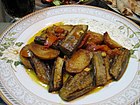Confit byaldi
 | |
| Type | Main course or side dish |
|---|---|
| Main ingredients | Courgette (zucchini), yellow squash, aubergine (eggplant), Roma tomatoes, yellow onions, garlic, herbs |
Confit byaldi is a variation on the traditional French dish ratatouille by the French chef Michel Guérard.
History
[edit]The name is a play on the Turkish dish "İmam bayıldı", which is a stuffed eggplant.[1][2]
The original ratatouille recipe has the vegetables fried before baking. Since at least 1976, some French chefs have prepared the ratatouille vegetables in thin slices instead of the traditional rough-cut. Michel Guérard, in his book founding cuisine minceur (1976),[3] recreated lighter versions of the traditional dishes of nouvelle cuisine.[4] His recipe, confit bayaldi, differed from ratatouille by not frying the vegetables, removing peppers and adding mushrooms.
American celebrity chef Thomas Keller first wrote about a dish he called "byaldi" in his 1999 book The French Laundry Cookbook.[5] Keller's variation of Guérard's added two sauces: a tomato and pepper sauce at the bottom (piperade), and a vinaigrette at the top.[6][7] He served as food consultant to the Pixar film Ratatouille, allowing its producer, Brad Lewis, to shadow for two days in the kitchen of his restaurant, the French Laundry. Lewis asked Keller how he would cook ratatouille if the most famous food critic in the world were to visit his restaurant.[1] Keller decided he would make the ratatouille in confit byaldi form, and fan the vegetable rounds accordion-style with a palette knife.[8]
Preparation and serving
[edit]
According to Thomas Keller's recipe, a piperade is made of peeled, finely chopped, and reduced peppers, yellow onions, tomatoes, garlic, and herbs. The piperade is spread thinly in a baking tray or casserole dish, then layered on top with evenly sized, thinly sliced rounds of zucchini, yellow squash, Japanese eggplant, and roma tomatoes, covered in parchment paper, then baked slowly for several hours to steam the vegetables. The parchment is removed so that the vegetables roast, acquiring additional flavor through caramelization. To serve, the piperade is formed into a small mound, and the rounds arranged in a fanned-out pattern to cover the piperade base. A balsamic vinaigrette is drizzled on the plate, which may be garnished.[9][10]
See also
[edit]References
[edit]- ^ a b Finz, Stacy (2007-06-28). "Bay Area flavors food tale: For its new film 'Ratatouille,' Pixar explored our obsession with cuisine". San Francisco Chronicle. Retrieved 2010-07-27.
- ^ Garr, Robin (2007-07-19). "Rat-atouille". Wine lovers page. Retrieved 2010-07-27.
- ^ Guérard, Michel (1977). Michel Guérard's Cuisine Minceur. Macmillan. pp. 221–4. ISBN 0-333-21907-4.
Ratatouille Niçoise is recipe No 144, while Confit bayaldi is No 141
- ^ Aldo Buzzi L'uovo alla kok
- ^ Keller, Thomas (November 1, 1999). The French Laundry Cookbook (2 ed.). Artisan. pp. 178–9. ISBN 1-57965-126-7.
- ^ "Recipe: Confit Byaldi". The New York Times. 2007-06-13. Retrieved 2010-07-27.
- ^ "Ratatouille recipe: Confit Byaldi". Inland Valley Daily Bulletin. 2007-07-09. Archived from the original on 2012-07-23. Retrieved 2010-07-27.
- ^ Severson, Kim (2007-06-13). "A Rat With a Whisk and a Dream". The New York Times. Retrieved 2010-07-27.
- ^ "A delightful renaissance of ratatouille". Ottawa Citizen. 2007-08-01. Archived from the original on 2012-11-07. Retrieved 2010-07-27.
- ^ Lyons, Gay (2007-08-02). "Ratatouille, for real". Metro Pulse. Archived from the original on February 25, 2012. Retrieved 2010-07-27.

